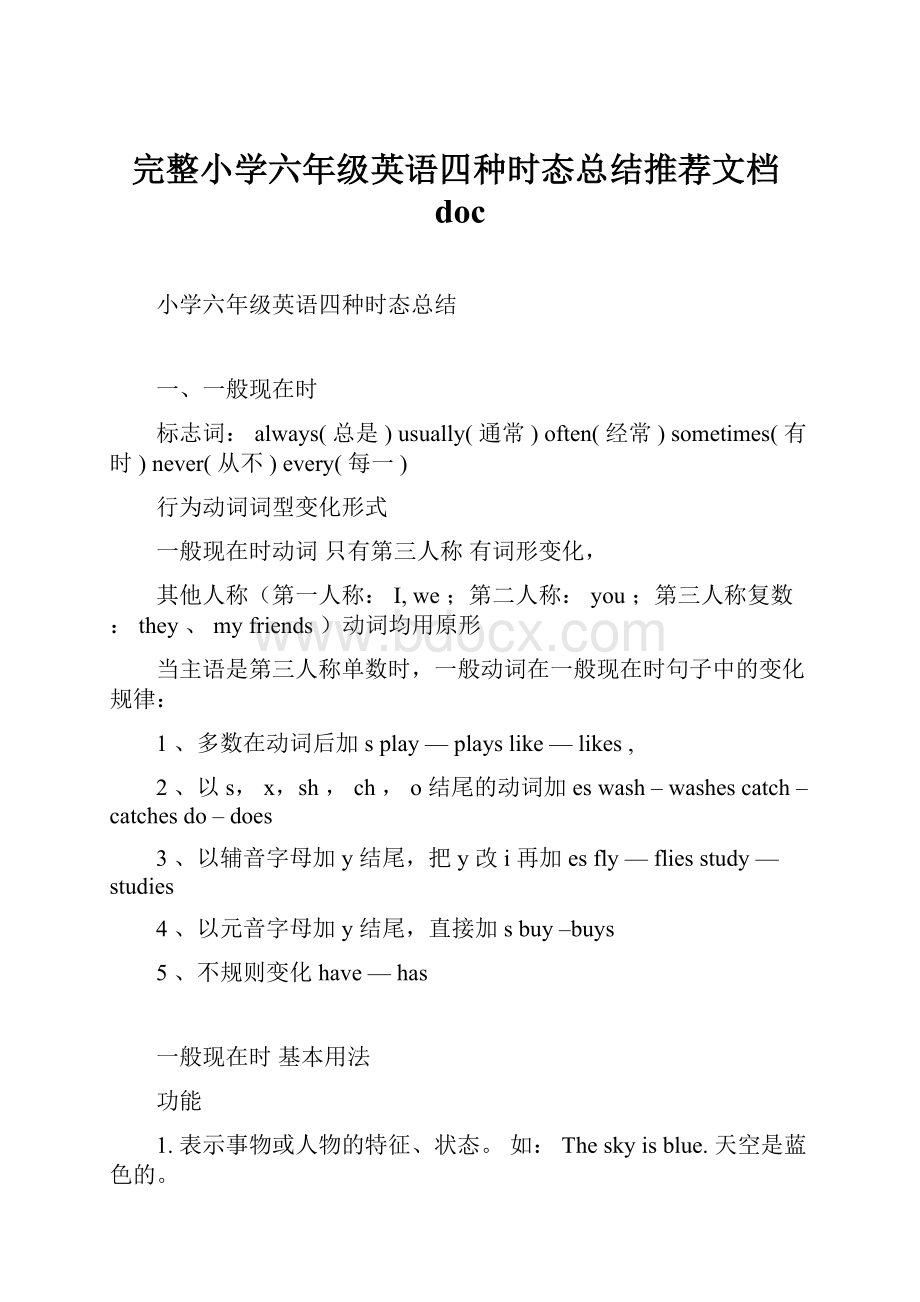完整小学六年级英语四种时态总结推荐文档doc.docx
《完整小学六年级英语四种时态总结推荐文档doc.docx》由会员分享,可在线阅读,更多相关《完整小学六年级英语四种时态总结推荐文档doc.docx(42页珍藏版)》请在冰豆网上搜索。

完整小学六年级英语四种时态总结推荐文档doc
小学六年级英语四种时态总结
一、一般现在时
标志词:
always(总是)usually(通常)often(经常)sometimes(有时)never(从不)every(每一)
行为动词词型变化形式
一般现在时动词只有第三人称有词形变化,
其他人称(第一人称:
I,we;第二人称:
you;第三人称复数:
they、myfriends)动词均用原形
当主语是第三人称单数时,一般动词在一般现在时句子中的变化规律:
1、多数在动词后加splay—playslike—likes,
2、以s,x,sh,ch,o结尾的动词加eswash–washescatch–catchesdo–does
3、以辅音字母加y结尾,把y改i再加esfly—fliesstudy—studies
4、以元音字母加y结尾,直接加sbuy–buys
5、不规则变化have—has
一般现在时基本用法
功能
1.表示事物或人物的特征、状态。
如:
Theskyisblue.天空是蓝色的。
2.表示经常性或习惯性的动作。
如:
Igetupatsixeveryday.我每天六点起床。
3.表示客观现实。
如:
Theearthgoesaroundthesun.地球绕着太阳转。
Theearthisround.
构成
1.be动词:
主语+be(am,is,are)+其它。
如:
Iamaboy.我是一个男孩。
2.行为动词:
主语+行为动词(+其它)。
如:
WestudyEnglish.我们学习英语。
句型
肯定句:
A.be动词:
主语+be+其它成分Heisaworker.
B.行为动词:
主语+动词(注意人称变化)+其它成分Welikethelittlecat.
否定句:
A.be动词:
主语+be+not+其它成分Theyarenotstudents.
B.行为动词:
主语+助动词(do/does)+not+动词原形+其它成分
Wedon’tlikethelittlecat.
一般疑问句:
A.be动词:
Am/Is/Are+主语+其它成分
Areyouateacher?
Yes,Iam./No,Iamnot.
Aretheystudentsofyourschool.Yestheyare/Notheyaren,t.
B.行为动词:
助动词(Do/Does)+主语+动词原形+其它成分
Doyoulikeit?
Yes,Ido./No.Idon’t.
Doeshe(she)likeit?
Yes,he(she)does./No,he(she)doesn’t.
特殊疑问句:
疑问词+一般疑问句
A.be动词:
Howmanystudentsarethereinyourschool?
B.行为动词:
WhatdoyouusuallydoonSunday?
一般现在时动词be和have的变化形式
1.动词Be叫连系动词,用法:
第一人称单数用am,第三人称单数用is,其它人称用are。
1
2.动词have的用法:
第三人称单数用has以外,其它人称一律用have。
如:
注意事项1.在英国,人们常用havegot代替have,特别在疑问句和否定句中。
2.当have如果不表示“有”时,构成疑问或否定句时,就借助于助动词do,does
如:
Ihaveanewpen.否:
Ihavenotanewpen.(表示有)
Ihavelunchat12o’clock.否:
Idon’thavelunchat12o’clock.(表示吃)
二.现在进行时:
标志词:
now,look,listen,It’s+时间.
现在进行时:
表示正在进行的、发生的动作
基本结构:
am
beis+动词ing
are
肯定句:
主语否定句:
主语一般疑问句:
+be动词(am,are,is)+现在分词(ing)+其他IamwatchingTV.
+be动词+not+现在分词(ing)+其他IamnotwatchingTV.
Be动词(Am,Are,Is)+主语+现在分词(ing)+其他
AreyouwatchingTV?
Yes,Iam./No,Iamnot.
特殊疑问句:
疑问词
+一般疑问句
Whatareyoudoing
?
动词的-ing形式的变化规律:
1.
直接加-ing
watch—watching
clean—cleaning
2.
以-y结尾的动词,直接加-ing
study—studying
play—playing
3.
以不发音的-e结尾的动词,先去
-e再加-ing
make—making
come—coming
4.末尾只有一个元音字母和一个辅音字母的重读闭音节动词,
双写末尾字母,再加-ingcut—cutting
三、一般将来时的用法:
表示将来某一时刻的动作或状态,或将来某一段时间内经常的动作或状态。
标志词:
tomorrow(明天),thedayaftertomorrow(后天),next(下一个),
fromnowon(从现在开始),inthefuture(将来),soon(不久)等
结构:
(1)be(am,is,are)+goingto+动词原形
(2)will+动词原形
“begoingto+动词原形(打算)”=”will+动词原形(将,会)”
I’mgoingtostudytomorrow.Iwillstudytomorrow.
2
(begoingto着重于事先考虑好will未事先考虑好)----一般不用考虑
肯定句:
主语+be(am,are,is)goingto+动词原形.
主语+will+动词原形
否定句:
主语+be(am,are,is)notgoingto+动词原形.
主语+won’t+动词原形.
一般疑问句:
Be(Am,Are,Is)+主语+goingto+动词原形?
Will+主语+动词原形?
特殊疑问句:
疑问词+一般疑问句?
注意:
will常简略为'll,并与主语连写在一起,如:
I'll,he'll,it'll,we'll,you'll,they'll。
四、一般过去时
标志词:
yesterday(昨天),last(上一个),thismorning(今天早上),ago(以前),
before(在之前),in2002(在2002年)等
用法:
表示过去某个时间发生的动作或存在的状态,常和表示过去的时间状语连用。
也表示过去经常或反复发生的动作
动词过去式变化规则:
1
.一般在动词末尾加
-ed
如:
watch-watched,cook-cooked
2
.结尾是e加d
如:
taste-tasted
3
.末尾只有一个元音字母和一个辅音字母的重读闭音节,应双写末尾的辅音字母,再加
-ed,如:
stop-stopped
4
.以“辅音字母+y”结尾的,变
y为i,再加-ed,如:
study-studied
5
.不规则动词过去式:
am,is-was,are-were,do-did,see-saw,say-said,give-
gave
句型:
1
、Be动词在一般过去时中的变化:
⑴am
和is变为was。
否定(wasnot=wasn
’t)
⑵are
变为were。
否定(werenot=weren
’t)
否定句:
在was或were后加not
一般疑问句:
把was或were调到句首。
2
、行为动词在一般过去时中的变化
否定句:
didn’t+动词原形
如:
Jimdidn
’tgohomeyesterday.
一般疑问句:
在句首加
Did,句子中的动词过去式变回原形
如:
DidJimgohomeyesterday?
特殊疑问句:
(1)疑问词+did+
主语+动词原形?
如:
WhatdidJimdoyesterday?
(2)疑问词当主语时:
疑问词
+动词过去式?
如:
Whowenttohomeyesterday?
3
附录:
小学常用不规则动词过去式
一、不规则动词的过去式的构成
1.把动词原形中的i改为a,变成过去式。
如:
begin—began,drink—drank,give—gave,ring—rang,sing—sang,sit—sat,swim—swam
2.把重读开音节中的i改为o,变成过去式。
如:
drive—drove,ride—rode,write—wrote
3.改动词原形中的aw/ow为ew,变成过去式。
如:
draw—drew,grow—grew,know—knew,throw—threw(动词show除外,show—showed)
4.动词原形中的e改为o,变成过去式。
如:
get—got,forget—forgot
5.动词原形中的ee改为e,变成过去式。
如:
feed—fed,meet—met
6.动词原形中的eep改为ept,变成过去式。
如:
keep—kept,sleep—slept,sweep—swept
7.动词原形中的eak改为oke,变成过去式。
如:
break—broke,speak—spoke
8.动词原形中的ell改为old,变成过去式。
如:
sell—sold,tell—told
9.动词原形中的an改为oo,变成过去式。
如:
stand—stood,understand—understood
10.以ought和aught结尾,且读音是〔:
t〕的过去式。
如:
bring—brought,buy—bought,think—thought,catch—caught,teach—taught
11.以ould结尾且读音为〔ud〕的情态动词过去式。
如:
can—could,shall—should,will—would
12.把动词原形中的o改为a,变成过去式。
如:
come—came,become—became
13.在动词原形后加d或t变成过去式,并且发生音变。
如:
hear〔hi〕—heard〔h:
d〕,say〔sei〕—said〔sed〕,mean〔mi:
n〕—meant
〔ment〕
14.动词的过去式与动词原形一样。
如:
let—let,must—must,put—put,read—read〔red〕
二.不规则动词表
原形过去式中文释义
amwas是(表示存在、状态等)
arewere是(表示存在、状态等)
4
become
became
成为;变成
begin
began
开始
break
broke
打破
bring
brought
拿来;取来;带来
build
built
构筑;建造;建筑
buy
bought
购买;买
can
could
可以;能;可能;会
catch
caught
赶上(车船等);捕获
come
came
来;来到
cut
cut
切;割;削;剪
do/does
did
做;干;行动
draw
drew
画
drink
drank
喝;饮
drive
drove
开车;驾驶
eat
ate
吃
feel
felt
感到;觉得
find
found
寻找;查找
fly
flew
飞行
forget
forgot
忘记;忘却
get
got
变得
give
gave
给;授予
go
went
去
have/has
had
得(病);患(病);有;吃;饮
hear
heard
听见;听说
hide
hid
隐藏
is
was
是(表示存在、状态等)
keep
kept
保持;使保持某种状态
know
knew
知道;了解
leave
left
离去;出发
let
let
允许;让
lose
lost
失去;丧失
make
made
使;促使;迫使;做;制作
may
might
可能;可以
mean
meant
表示的意思;作的解释
meet
met
遇见;相逢
put
put
放;摆;装
read
read/e/
读;阅读
ride
rode
骑
ring
rang
(铃)响
rise
rose
上升
run
ran
跑;奔跑
say
said
说;讲
see
saw
看见
send
sent
发送;寄;派;遣
5
set
set
放,置
show
showed
出示;给看
shut
shut
关上(门、盖、窗户等)
sing
sang
唱;唱歌
sit
sat
坐
sleep
slept
睡;睡觉
speak
spoke
说;说话
swim
swam
游泳
take
took
搭乘;花费(时间);拿走;带到
teach
taught
教;讲授
tell
told
告诉;讲述
think
thought
想;思考
will
would
将要
win
won
赢;获胜
write
wrote
书写
小学英语语法(词性)总结
一、形容词、副词的比较级和最高级的用法:
当两种物体之间相互比较时,我们要用形容词或副词的比较级;当相互比较的物体是三个或三个以上时,用形容词或副词的最高级。
比较级
二者比较,标志词:
than
最高级
三者以上比较,标志词:
the
形容词、副词的比较级和最高级的变化规律:
1.单音节形容词或副词后面直接加-er或-esttall—taller—tallestfast—faster—fastest
6
2.以-e结尾的单音节形容词或副词直接加-r或-stlarge—larger—largestnice—nicer—nicest
3.以-y结尾的形容词或副词,改-y为-i再加-er或-est
busy—busier—busiest
early—earlier—earliest
4.
形容词或副词是重读闭音节时,双写最后的辅音字母,再加
-er或-est
hot—hotter—hottest
5.
多音节形容词或副词前面直接加
more或most
beautiful
—morebeautiful
—mostbeautiful
6.
以ly结尾的副词一般加
more或most
slowly—moreslowly—mostslowly
7.
不规则变化
good(well)-better-best
bad(badly)-worse-worst
little-less-least
far-farther-further
many(much)-more–most
形容词、副词的比较级和最高级用法:
比较级:
1、形容词:
物体A+am/are/is+
形容词比较级
+than+
物体B
Iamtallerthanyou.
Thispictureismorebeautifulthanthatone.
2、副词:
物体A+
行为动词
+副词比较级
+than+
物体B.
Hestudiesbetterthanme.
最高级:
1、形容词:
物体A+am/are/is+the+
形容词最高级+
比较范围(of+
人/物,in+地方).
Iamthetallestintheclass.
ShanghaiisoneofthebiggestcitiesinChina.
2、副词:
物体A+
行为动词
+副词最高级
+比较范围(of+人/物,in+
地方).
Cheetahsrunfastestintheworld.
Hestudiesbestofus.
表示两者对比相同:
主语+谓语+as+形容词/副词原形+as+从句
Thisboxisasbigasmine.
Thiscoatisnotso/ascheapasthatone.
IstudyEnglishashardasmybrother.
英语比较级和最高级练习
(一)1.Apigis__thanadog.
A.muchheavyB.moreheavier
CmuchheavierD.moreheavy
2.--Whichis__seasoninBeijing?
--Ithinkit’spring.
A.goodB.wellC.bestD.thebest
3.Thecityisbecoming______.
A.morebeautifulandmore
B.morebeautifulandbeautiful
C.moreandmorebeautiful
D.morebeautifulandbeautifuler
4.WhichdoesAlicelike_____,ChineseorArt?
A.wellB.bestC.betterD.much
7
5.TheChangjiangRiverisoneof
____in
theworld.
A.thelongestriver
B.longestrivers
C.thelongestrivers
D.longer
rivers
6.LiMing
speaksChinese_____
betterthanme.
A.very
B.moreC.alot
ofD.much
7.Thereare____
boysin
ClassTwo
thaninClassFour.
A.moreB.manyC.mostD.best
8.Whohas_____orangesnow,Jim,Lily
orLucy?
A.muchB.biggestC.betterD.themost
9.Mother
is_____inmyfamily.
A.busyB.busierC.thebusiestD.more
10.Nooneis_____Lucyintheclass.
A.sotallestasB.astalleras
C.sohighasD.astallas
(二)写出下列形容词与副词的比较级与最高级形式:
long___________wide_____________fat_________
heavy__________slow_____________few_________
brightly______-_____bably____________far_________
quickly___________happy_____-______unhappy________
(三)用所给词的正确形式填空:
1.Ofthetwogirls,IfindLucythe_______(clever).
2.Gold(黄金)is______(little)usefulthaniron(铁).
3.Mysisteristwoyears_______(old)thanI.
4.John’sparentshavefourdaughters,andsheisthe_____(young)child.
5.The_____(cheap)bagsarethenotusuallythebestones.
6.Theshortoneisbyfar_______expensiveofthefive.
7.Theboyisnotso_____